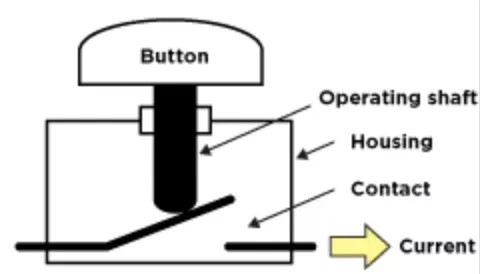Кнопки аварийного останова, широко используемые в промышленности и системах безопасности, как правило, имеют нормально замкнутые (НЗ) контакты. Такая конфигурация обеспечивает отказоустойчивость механизма, позволяя при активации немедленно прервать подачу питания на оборудование, что повышает безопасность и эксплуатационную надежность.
Сравнение между нормально разомкнутыми и нормально замкнутыми контактами
| Нет контакта | NC Контакт | |
|---|---|---|
| Электрический символ |  |
 |
| Обзор структуры переключателя (состояние перед началом работы) |  |
 |
| Пояснение |
|
|
| Использование в качестве цепи аварийного останова | НЕТ | ДА |
| Поведение при размыкании цепи или нарушении проводимости | Во время работы ток не протекает. ->Если используется в качестве цепи аварийного останова, машина не останавливается при нажатии кнопки. (Опасный отказ машины) |
Ток не протекает даже при сбросе кнопки. -> Кнопка сброса не может быть распознана из-за структуры схемы, поэтому машина не может работать. (Безопасный отказ машины) |
Конфигурация кнопки аварийного останова
В конструкции кнопок аварийного останова обычно используются нормально замкнутые (НЗ) контакты, обеспечивающие состояние по умолчанию, когда электрические контакты задействованы и ток протекает через цепь. Такая конфигурация крайне важна для обеспечения безопасности работы в промышленных условиях. При активации кнопки ее контакты размыкаются, немедленно прерывая подачу питания на подключенное оборудование и вызывая его быстрое отключение. Международные стандарты безопасности рекомендуют такой подход, поскольку он обеспечивает более надежный и быстродействующий механизм аварийного останова по сравнению с нормально разомкнутыми (NO) конфигурациями. Использование нормально разомкнутых контактов в кнопках электронного останова является широко распространенной практикой в различных отраслях промышленности, где приоритет отдается безопасности работников и защите оборудования.
Механизм немедленного реагирования
Быстрое срабатывание нормально замкнутых (НЗ) кнопок аварийного останова является критически важным элементом безопасности в промышленных условиях. При активации эти кнопки мгновенно размыкают цепь, отключая питание оборудования за миллисекунды. Такое мгновенное прерывание работы имеет решающее значение для предотвращения несчастных случаев и минимизации возможных травм в аварийных ситуациях. Быстрый переход из замкнутого в разомкнутое состояние гарантирует, что даже если кнопка нажата не полностью, она все равно сможет эффективно остановить работу. Такой выбор конструкции ставит во главу угла безопасность работников, обеспечивая практически мгновенное отключение, что делает нормально замкнутые контакты предпочтительной конфигурацией для систем аварийного останова в различных отраслях промышленности.
Безотказная конструкция безопасности
Отказоустойчивая конструкция нормально замкнутых (НЗ) кнопок аварийного останова обеспечивает дополнительный уровень безопасности в промышленных условиях. При возникновении неисправности в цепи, такой как размыкание или обрыв провода, конфигурация NC гарантирует, что оборудование автоматически прекратит работу. Эта неотъемлемая функция безопасности предотвращает работу оборудования, когда оно не должно работать, снижая риск несчастных случаев или повреждения оборудования. Механизм отказоустойчивости особенно ценен в ситуациях, когда непрерывная работа может представлять опасность, поскольку он по умолчанию переходит в безопасное состояние даже в случае сбоев в системе или потери питания. Такая философия проектирования соответствует международным стандартам безопасности и передовой практике для систем аварийного останова, уделяя первостепенное внимание защите работников и целостности оборудования в потенциально опасных средах.
Преимущества эксплуатационной надежности
Нормально закрытая конфигурация кнопок аварийной остановки повышает надежность работы несколькими способами. Поддерживая замкнутый контур во время нормальной работы, эти кнопки могут обнаруживать и реагировать на частичные срабатывания, обеспечивая безопасность даже при неполном нажатии. Такая конструкция также позволяет постоянно контролировать целостность цепи, немедленно вызывая отключение при возникновении любых неисправностей или разъединений. Кроме того, настройка NC снижает вероятность ложных срабатываний или непреднамеренных активаций, поскольку для разрыва цепи требуется целенаправленное действие. Все эти функции в совокупности способствуют созданию более прочной и надежной системы аварийного отключения, что крайне важно для поддержания стандартов безопасности в промышленных условиях, где важна быстрая и надежная реакция.


